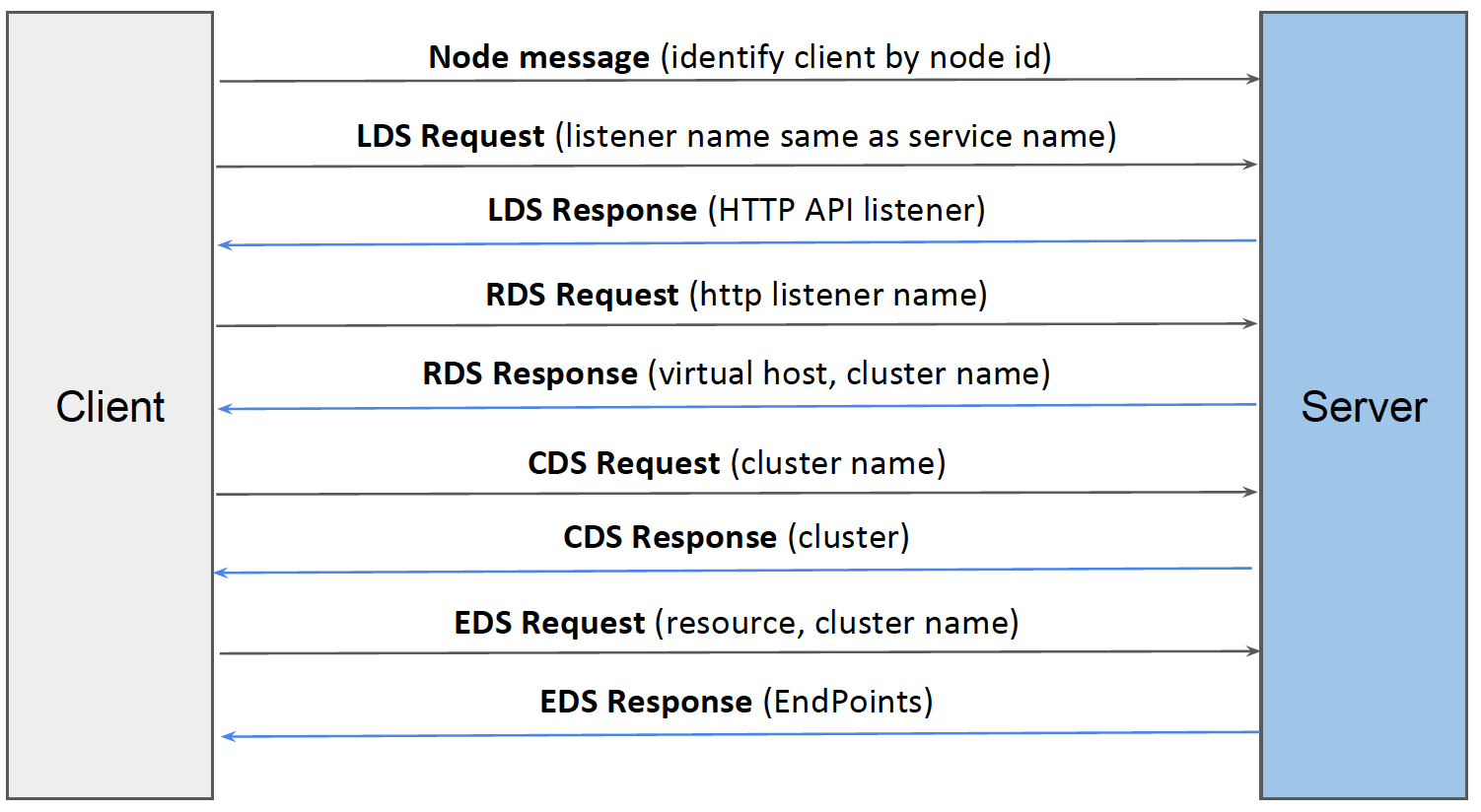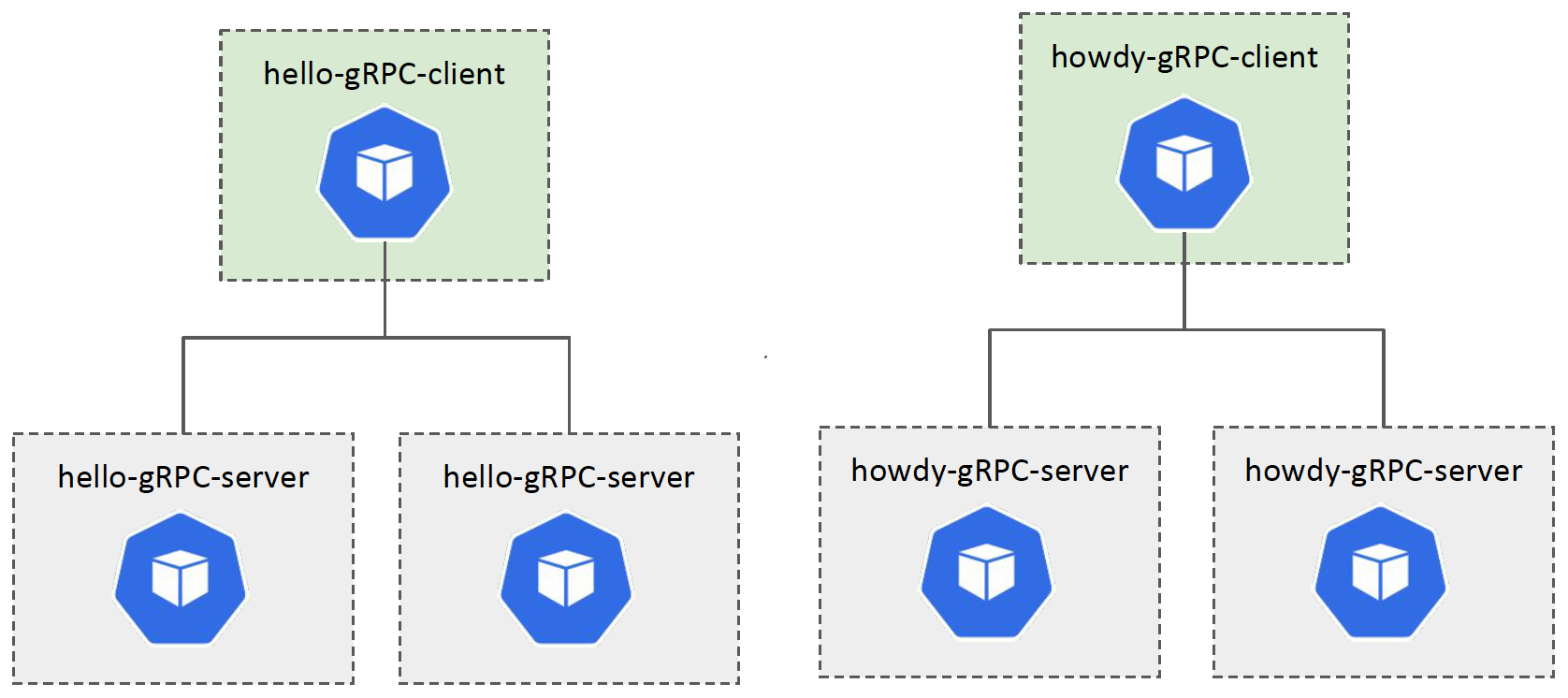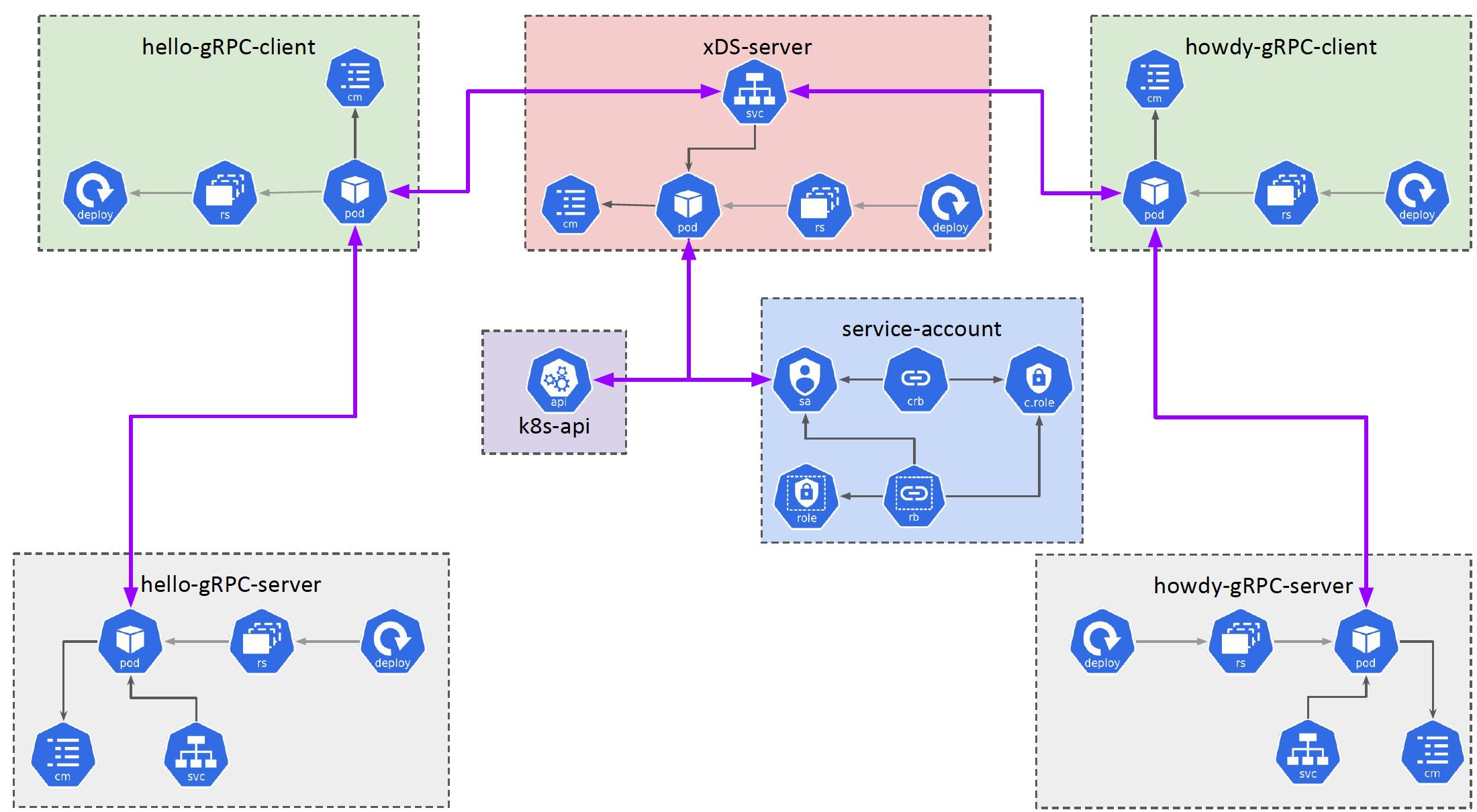
In this post, I will show how you can build a proxy-less load balancing for your gRPC services using the new xDS load balancing.
You can find the complete code for this experiment in asishrs/proxyless-grpc-lb
Why is load balancing in gRPC difficult?#
If you are building gRPC based applications, you may already be aware of the usage of HTTP2 in gRPC. If you are unfamiliar with that, please read below
- https://grpc.io/blog/grpc-load-balancing/
- https://kubernetes.io/blog/2018/11/07/grpc-load-balancing-on-kubernetes-without-tears/
At a high-level, I want you to understand two points.
- gRPC is built on HTTP/2, and HTTP/2 is designed to have a single long-lived TCP connection.
- To do gRPC load balancing, we need to shift from connection balancing to request balancing.
What are the options?#
There used to be two options to load balance gRPC requests in a Kubernetes cluster
- Headless service
- Using a Proxy (example Envoy, Istio, Linkerd)
Recently gRPC announced the support for xDS based load balancing, and as of this time, the gRPC team added support in C-core, Java, and Go languages. This is an essential feature as this will open a third option for load balancing in gRPC, and I will show how to do that in a Kubernetes cluster. gRPC will be moving from its original grpclb protocol to the new xDS protocol.
xDS API#
xDS API is a suite of APIs becoming popular and evolving into a standard used to configure various data plane software.
In the xDS API flow, the client uses the following main APIs:
- Listener Discovery Service (LDS): Returns Listener resources. Used basically as a convenient root for the gRPC client’s configuration. Points to the RouteConfiguration.
- Route Discovery Service (RDS): Returns RouteConfiguration resources. Provides data used to populate the gRPC service config. Points to the Cluster.
- Cluster Discovery Service (CDS): Returns Cluster resources. Configures things like load balancing policy and load reporting. Points to the ClusterLoadAssignment.
- Endpoint Discovery Service (EDS): Returns ClusterLoadAssignment resources. Configures the set of endpoints (backend servers) to load balance across and may tell the client to drop requests.
gRPC load balancing using xDS API#
To leverage xDS load balancing, the gRPC client needs to connect to the xDS server. Clients need to use xds resolver in the target URI used to create the gRPC channel.
The diagram below shows the sequence of API calls.

xDS API calls
The xDS server is responsible for discovering the EndPoints for the gRPC server and communicate that to the client. The client then asks for updates in a periodic interval.
xDS EndPoint Discovery in Kubernetes cluster#
In this example, I am using k8s client-go to discover the EndPoints and Envoy go-control-plane as the xDS server. In my implementation, the xDS server polls the Kubernetes endpoints every minute and updates the xDS snapshot with the gRPC server IP address and port. Since I am using a minute interval for polling, clients may take up to a minute to reflect the Endpoint updates.

Note: Envoy go-control-plane doesn’t support multiple gRPC client requests. I am using a forked version with a fix for this. I have an issue open to discuss the same with the Envoy team.
Example Application#
I am using two gRPC services (hello and howdy) and clients connecting to those in a load-balanced way in this example application. The below diagram shows the setup.

See all in Action#
To test the repository quickly, I am going to run all commands via Go Task. You can look into the all commands in the Taskfile.yml (or Taskfile-*.yml) files.
Deploy the components#
# XDS Server
# Build xDS Server
task xds:build
# Deploy xDS Server
task xds:deploy
# You can run above in a single command
task xds:build xds:deploy
# gRPC Server
# Build gRPC Server
task server:build
# Deploy gRPC Server
task server:deploy
# You can run above in a single command
task server:build server:deploy
# gRPC Client
# Build gRPC Client
task client:build
# Deploy gRPC Client
task client:deploy
# You can run above in a single command
task client:build client:deploy
Optional Step — Verify all components
Check all the components are running.
Run kubectl get deployments.apps to check all deployments. You must see five deployments in the list.
NAME READY UP-TO-DATE AVAILABLE AGE
hello-client 1/1 1 1 4d23h
howdy-client 1/1 1 1 4d23h
hello-server 2/2 2 2 4d23h
howdy-server 2/2 2 2 4d23h
xds-server 1/1 1 1 5d
Run kubectl get svc to check all services. You must see four services on the list.
NAME TYPE CLUSTER-IP EXTERNAL-IP PORT(S) AGE
kubernetes ClusterIP 10.43.0.1 <none> 443/TCP 14d
xds-server ClusterIP 10.43.113.60 <none> 18000/TCP 5d
hello-server ClusterIP 10.43.78.196 <none> 50051/TCP 4d23h
howdy-server ClusterIP 10.43.228.201 <none> 50052/TCP 4d23h
Run kubectl get pods to check all pods. You must see seven pods on the list. The pod suffix (after the last -) is going to be different each time.
NAME READY STATUS RESTARTS AGE
howdy-client-659b8f99f5-q6fvx 1/1 Running 1 4d23h
hello-client-5f7bdc5f68-2vkfs 1/1 Running 1 4d23h
xds-server-86c5f6bfcf-f8wks 1/1 Running 1 5d
hello-server-b9ff98f5b-cgvk7 1/1 Running 1 4d23h
howdy-server-7d79c584f6-xbv4l 1/1 Running 1 4d23h
hello-server-b9ff98f5b-l7dmc 1/1 Running 1 4d23h
howdy-server-7d79c584f6-d54zs 1/1 Running 1 4d23h
Validate Proxyless (xDS) load balancing#
The server responds to the gRPC requests in the code by adding the server host IP. We can use this to identify the target server responding to the client request.
Let’s check the logs from hello client by running kubectl logs -f deployment/hello-client
There are two essential things in the logs.
xDS calls
You can see logs initiating connections with the xDS server and getting the server’s xDS protocol response. This is the point where the client-side load balancer picks the available connections.
Example response
INFO: 2020/09/07 01:31:28 [xds] [eds-lb 0xc0002ce820] Watch update from xds-client 0xc0001502a0, content: {Drops:[] Localities:[{Endpoints:[{Address:10.42.0.234:50052 HealthStatus:1 Weight:0} {Address:10.42.1.138:50052 HealthStatus:1 Weight:0}] ID:my-region-my-zone- Priority:0 Weight:1000}]}
gRPC Server Response
You can see the gRPC server responding to the client requests. Using the IP address in the gRPC response, you can see that the response comes from both replicas of hello-grpc-server apps.
Example response
{"level":"info","caller":"client/client.go:51","msg":"Hello Response","Response":"message:\"Hello gRPC Proxyless LB from host howdy-server-7d79c584f6-xbv4l\""}
{"level":"info","caller":"client/client.go:51","msg":"Hello Response","Response":"message:\"Hello gRPC Proxyless LB from host howdy-server-7d79c584f6-d54zs\""}
{"level":"info","caller":"client/client.go:51","msg":"Hello Response","Response":"message:\"Hello gRPC Proxyless LB from host howdy-server-7d79c584f6-xbv4l\""}
{"level":"info","caller":"client/client.go:51","msg":"Hello Response","Response":"message:\"Hello gRPC Proxyless LB from host howdy-server-7d79c584f6-d54zs\""}
Similarly, you can check the howdy-client logs kubectl logs -f deployment/howdy-client
Final Diagram
Here is the diagram representing, the whole setup.

Next Steps#
What about scaling the deployments? You can scale (up and down) the gRPC server (both hello and howdy) deployments and see how the xDS load balancing will behave. It may take up to a minute for the client to pick up the changes.
# Scale hello-server to 5 replicas
kubectl scale — replicas=5 deployments.apps/hello-server
# Scale howdy-server to 5 replicas
kubectl scale — replicas=5 deployments.apps/howdy-server
Bonus Diagram#
Here is the diagram with every call in this experiment.

References#
- https://www.envoyproxy.io/docs/envoy/latest/api-docs/xds_protocol
- https://github.com/grpc/proposal/blob/master/A27-xds-global-load-balancing.md
- https://github.com/envoyproxy/data-plane-api/tree/master/envoy/api/v2
- https://github.com/grpc/grpc-go/blob/master/examples/features/xds/README.md
- https://github.com/envoyproxy/go-control-plane/issues/349
- https://medium.com/@salmaan.rashid/grpc-xds-loadbalancing-a05f8bd754b8

